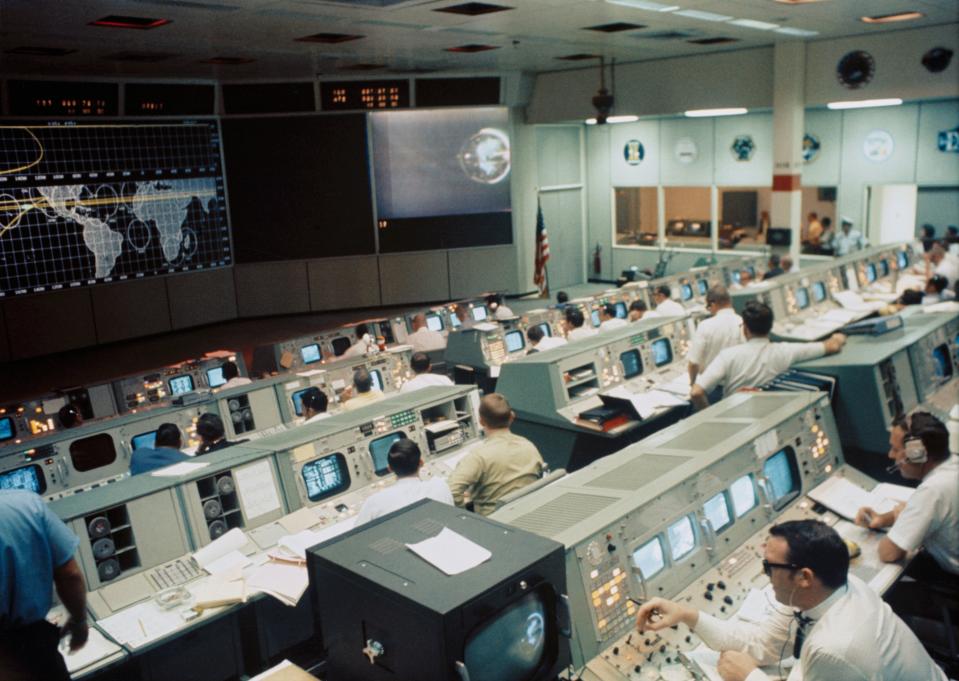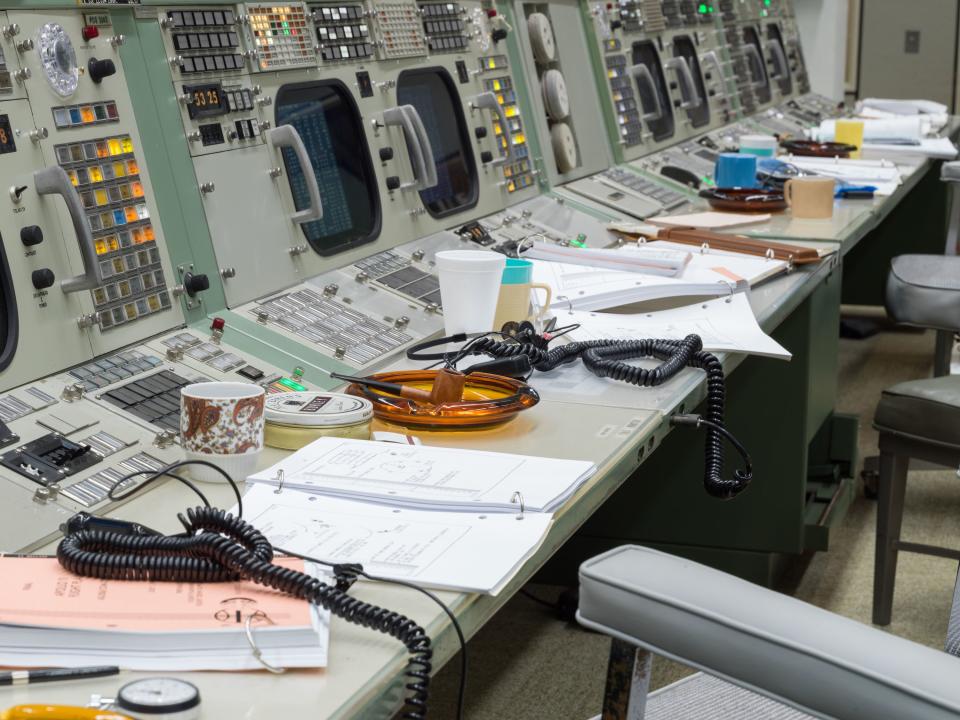How NASA Restored Mission Control for the 50th Anniversary of the Moon Landing
When you step through the door to NASA’s historic Mission Operations Control Room 2, you’re stepping back in time to July 20, 1969, the day Neil Armstrong and Buzz Aldrin first set foot on the moon. Coffee mugs dot the consoles, where ashtrays, pencils, and binders also sit slightly askew. It’s as if the men who operated the machines have simply stepped out for a break—and that’s intentional. On June 29, 2019, NASA officially reopened Mission Control after a $5 million restoration that ensured every last detail, from the displays on the consoles to the carpet on the floor, was brought back to life.
The site, which had been added to the U.S. National Register of Historic Places in 1985, had suffered wear and tear over the decades after being used not only for the Gemini and Apollo missions but also for the Space Shuttle. Then, when NASA opened a new facility in the same building in 1998, historic Mission Control was hurriedly returned to its Apollo 15–era configurations. The room was occasionally visited by tourists or curious staffers, but otherwise, it languished.
Six years ago, Johnson Space Center’s historic preservation officer Sandra Tetley took action. “I applied for a grant from the National Park Service heritage partnership program. What I wanted was $5,000 to create a visitor experience in the viewing room,” says Tetley. “The Park Service came down, and when they saw the state of Mission Control, they offered me $20,000 and a $20,000 matching grant to do a historic furnishing survey, which was a meticulous analysis of what it would take to bring the room back to its original state.”

While NASA itself didn’t have room in its budget for the restoration, it wasn’t terribly difficult to fundraise. The city of Webster, a Houston suburb near Johnson, where many NASA employees lived, donated the majority of the funds, while a Kickstarter campaign added to the sum.
It was obvious that the iconic green mint consoles needed to be restored—they were updated for use during the Space Shuttle program from 1981 to 1992, then subsequently restored to their original condition during the Apollo 15 mission when the room was retired. For the most recent update, they were sent to the Cosmosphere in Hutchinson, Kansas, where they were restored by the SpaceWorks division to feature not only the original hardware-like buttons but also the displays on the monitors. But the bones of the room itself, from the carpet to the ceiling tiles, were in desperate need of updating, after the wear and tear of decades of use—and plenty of clouds of tobacco smoke.
Stern and Bucek Architects was tasked with the restoration, with principal David Bucek, project manager Jordan Shelton, and preservation specialist Delaney Harris-Finch working in tandem with Tetley. The process began with a deep dive into all available material on the room, from photographs from NASA’s archives to the original blueprints of the room to, sometime later on in the process, the newly discovered film footage that became the 2019 documentary Apollo 11. “We consulted with all the flight directors that were available to talk about their consoles and what they did at them,” said Bucek. “They really wanted visitors to see what they saw, not something new or made up to tell another story.”
The process that followed was nothing short of a NASA-appropriate science experiment. The restoration team was able to find original samples across the site, from wallpaper tucked behind a fire extinguisher to an untouched patch of carpet beneath a piece of equipment to ceiling tiles in a phone booth in the building’s lobby—these samples were then subjected to forensic analysis for further research, which led to the discovery of the original manufacturers for the products.
The wallpaper, for instance, was traced to one company that had been since acquired by a new one—that new company conveniently had the original rollers for the paper, and it reprinted the wallpaper for the restoration. The carpet, on the other hand, couldn’t be replicated quite as precisely. In the 1960s, carpet was woven on a loom, but today it’s created using tufting machines. Though the restoration team was able to locate the manufacturer of the carpet, Bigelow’s Mohawk division, the method to re-create the exact carpet couldn’t be replicated. But the company created a custom product that appears practically identical to the original.
The restoration team’s attention to detail even extended to the exact pattern of holes on the ceiling tiles. “One of our consultants located an Apollo-era ceiling tile in one of the phone booths in the lobby of the building,” says Shelton. “Standard contemporary ceiling tiles met the specs but didn't have the same pattern.” So Shelton hand-pricked holes in a new tile to match the original exactly—the pattern was made into a mold by the manufacturer, then stamped on each tile installed on the ceiling of Mission Control.

The team went a step beyond restoring the bones of the room—they staged it as if it were completely untouched since the day humans first landed on the moon. A number of flight controllers donated some of their personal items from their days at Johnson for the staging, but other items had to be sourced separately.
“We have some original items that were in the room, like some of the reel-to-reel recorders and some slide rulers,” says Harris-Finch. “Sandra also did a big email blast through the Space Center distribution list asking for any donations of items that might still be around the campus, so we were able to get bookshelves, trash bins, binders, coat racks, metal hangers, pens, pencils, clipboards—anything around here for the from the Apollo era.”
The chairs at Johnson Space Center, however, are replaced about every three years, so it was difficult to source the ones from 1969 from the campus alone. They ended up being traced to the original manufacturer, Steelcase, whose archivist was able to share the precise specs of the model used during Apollo 11. Though the upholstery was no longer available, the team commissioned a local weaver to create a replica of the original for the restoration.
And some of the items that needed to be sourced were of a more personal nature, like the coffee mugs, which flight controllers brought from home. “Every coffee mug you see on a console, I saw that coffee mug on a console in a photograph dated 1969,” says Harris-Finch. From the photographs, she deduced the make and model of each mug and sourced them from vintage retailers and websites suchas eBay and Etsy. “This was a historic restoration where every decision, every choice, every material was based off of evidence,” says Harris-Finch. Visitors to Space Center Houston can see the restored Mission Control via the tram tour of NASA’s campus, which will play a part in this weekend’s festivities for the 50th anniversary of the moon landing—July 20, 2019.
Originally Appeared on Architectural Digest

